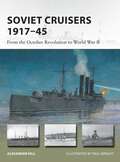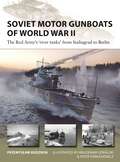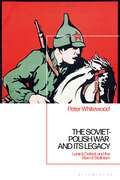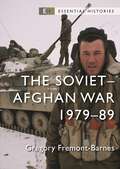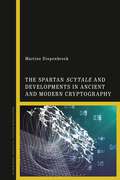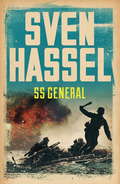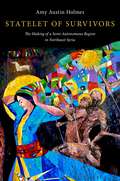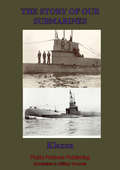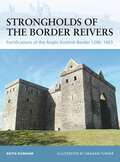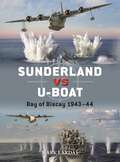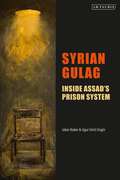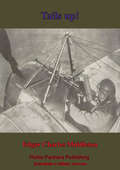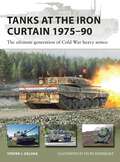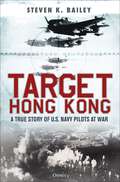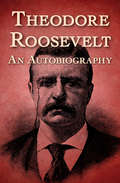- Table View
- List View
Soldiers as Citizens: Popular Politics and the Nineteenth-Century British Military (Studies in Labour History #12)
by Nick MansfieldRank and file soldiers were not ‘the scum of the earth’ but included a cross section of working-class men, who retained their former civilian culture. While they often exhibited pride in regiment and nation, soldiers could also demonstrate a growing class consciousness and support for political radicalism. The book will challenge assumptions that the British army was politically neutral, if privately conservative, by uncovering a rich vein of liberal and radical political thinking among some soldiers, officers and political commentators. This ranges from the Whig ‘militia’ tradition, through radical theories on tactics and army reform, to attempted ultra-radical subversion amongst troops, and the involvement of soldiers in riots and risings. Case studies are given of individual 'military radicals', soldiers or ex-soldiers who were reforming and later socialist activists. Popular anti-French feeling of the Napoleonic Wars is examined, alongside examples of rank and file bravery which fostered widespread loyalty and patriotism. This contributed to soldiers being used successfully in strike breaking, and deployed against rioters or Chartist revolts. By the late Victorian period, popular imperialism was an important part of working-class support for Conservatism. The book explores what impact this had on rank and file soldiers, whilst outlining minority support for socialism.
Soviet Cruisers 1917–45: From the October Revolution to World War II (New Vanguard #326)
by Dr Alexander HillA history of the Soviet Navy's cruisers, from the opening shots of the October Revolution through to the combat they saw during World War II.The Soviet Navy of World War II boasted a cruiser fleet that was among the most eclectic to see service. In this book, noted military historian and Soviet specialist Alexander Hill explains the role of cruisers in the Soviet Navy from the dramatic days of the October Revolution of 1917 through to the struggle they fought with Nazi Germany during World War II. Illustrated throughout with rare photos and original artwork, including a cutaway of Aurora, famous for its role in the Bolshevik October Revolution, and with profiles of the key classes, this book outlines the Soviets' development of a cruiser force. Having inherited a number of cruisers from the Imperial Russian Navy, the new Soviet Navy went on to complete two unfinished Tsarist light cruisers during the 1920s. In the late 1930s, the Soviets built their first large warships, the Kirov class, and in 1940 Nazi Germany sold the unfinished heavy cruiser Lützow to the USSR. The final cruiser-sized warship to see action was the former Imperial royal yacht Shtandart, renamed Marti and armed as a minelayer, which was used in the defence of Leningrad. Researched in the main from Russian-language sources, this study explores the cruiser fleet that saw considerable action in World War II, particularly in support of the Red Army.
Soviet Motor Gunboats of World War II: The Red Army's 'river tanks' from Stalingrad to Berlin (New Vanguard #324)
by Przemyslaw BudzbonA compelling account of the heavily armed and highly mobile Soviet river gunboats which took on the Germans during World War II.Russia's enormous river system has long been its highway and, as early as 1908, the Tsar's armies were developing armoured riverboats that brought tank-like mobility, firepower and survivability to Russian battlefields.This book, the first history of these vessels in English, explains how this concept led to one of the most remarkable naval weapons of World War II, the Soviet 'river tank', or Armoured Motor Gun Boat (AMGB). Highly mobile, capable of carrying up to 20 infantrymen directly into action and providing immediate firepower from their tank turrets, machine guns or Katyusha rockets, their military value was widely recognized. They were versatile enough to be used in naval landing operations off the Gulf of Finland, the Azov Sea and the Black Sea, and their capabilities were prized by local commanders.Using meticulously researched new colour profiles, rare photos and spectacular artwork, this book uncovers the history of river warfare on the Eastern Front, and the boats that played such a key part in the fighting.
The Soviet-Polish War and its Legacy: Lenin’s Defeat and the Rise of Stalinism
by Peter WhitewoodThis detailed study traces the history of the Soviet-Polish War (1919-20), the first major international clash between the forces of communism and anti-communism, and the impact this had on Soviet Russia in the years that followed. It reflects upon how the Bolsheviks fought not only to defend the fledgling Soviet state, but also to bring the revolution to Europe. Peter Whitewood shows that while the Red Army's rapid drive to the gates of Warsaw in summer 1920 raised great hopes for world revolution, the subsequent collapse of the offensive had a more striking result. The Soviet military and political leadership drew the mistaken conclusion that they had not been defeated by the Polish Army, but by the forces of the capitalist world – Britain and France – who were perceived as having directed the war behind-the-scenes. They were taken aback by the strength of the forces of counterrevolution and convinced they had been overcome by the capitalist powers. The Soviet-Polish War and its Legacy reveals that – in the aftermath of the catastrophe at Warsaw –Lenin, Stalin and other senior Bolsheviks were convinced that another war against Poland and its capitalist backers was inevitable with this perpetual fear of war shaping the evolution of the early Soviet state. It also further encouraged the creation of a centralised and repressive one-party state and provided a powerful rationale for the breakneck industrialisation of the Soviet Union at the end of the 1920s. The Soviet leadership's central preoccupation in the 1930s was Nazi Germany; this book convincingly argues that Bolshevik perceptions of Poland and the capitalist world in the decade before were given as much significance and were ultimately crucial to the rise of Stalinism.
The Soviet–Afghan War: 1979–89 (Essential Histories)
by Gregory Fremont-BarnesA fully illustrated overview of the USSR's bloody conflict in Afghanistan and its long legacy.The Soviet invasion of its neighbour Afghanistan in December 1979 sparked a nine-year conflict until Soviet forces withdrew in 1988–89, dooming the communist Afghanistan government to defeat at the hands of the mujahideen, the Afghan popular resistance backed by the USA and other powers. Gregory Fremont-Barnes reveals how the Soviet invasion had enormous implications on the global stage; it prompted the US Senate to refuse to ratify the hard-won SALT II arms-limitation treaty, and the USA and 64 other countries boycotted the 1980 Moscow Summer Olympics. For Afghanistan, the invasion served to prolong the interminable civil war that pitted central government against the regions and faction against faction. Updated and revised for the new edition, with full-colour maps and new images throughout, this succinct account explains the origins, events and consequences of the Soviet intervention in Afghanistan, shedding new light on the more recent history – and prospects – of that troubled country.
The Spartan Scytale and Developments in Ancient and Modern Cryptography
by Dr Martine DiepenbroekThis book offers a comprehensive review and reassessment of the classical sources describing the cryptographic Spartan device known as the scytale. Challenging the view promoted by modern historians of cryptography which look at the scytale as a simple and impractical 'stick', Diepenbroek argues for the scytale's deserved status as a vehicle for secret communication in the ancient world. By way of comparison, Diepenbroek demonstrates that the cryptographic principles employed in the Spartan scytale show an encryption and coding system that is no less complex than some 20th-century transposition ciphers. The result is that, contrary to the accepted point of view, scytale encryption is as complex and secure as other known ancient ciphers. Drawing on salient comparisons with a selection of modern transposition ciphers (and their historical predecessors), the reader is provided with a detailed overview and analysis of the surviving classical sources that similarly reveal the potential of the scytale as an actual cryptographic and steganographic tool in ancient Sparta in order to illustrate the relative sophistication of the Spartan scytale as a practical device for secret communication. This helps to establish the conceptual basis that the scytale would, in theory, have offered its ancient users a secure method for secret communication over long distances.
Spoils of War in the Arab East: Reconditioning Society and Polity in Conflict
Post-conflict scenarios are often proposed for Arab countries that have witnessed significant changes and civil wars. Yet the plans for reconciliation, transitional justice, and the return of the displaced often overlook the real conditions that make these recommendations impossible. This book provides a critical analysis of current post-conflict frameworks for Syria and Iraq. Drawing on empirical research, the book shows that reconciliation and reconstruction scenarios need to be considered alongside the realities on the ground. It argues that Iraq and Syria exist in a condition of 'conflict transformation' rather than of 'conflict termination', because the extreme changes that accompanied these countries into war continue long after the conflicts end. Furthermore, the chapters highlight why experts should not seek solutions in culturalist terms and ancestral enmities, or rely on the wartime status quo. Rather, they should look to the specific military, political, economic and socio-cultural conditions that require different solutions. A critical analysis of existing post-conflict frameworks, their applicability and their potential outcomes in Iraq and Syria, the book is a vital contribution to post-conflict studies. It highlights the need for new approaches to reconstruction and peacebuilding in Arab countries and points to how they should be found.
SS General (Sven Hassel War Classics)
by Sven HasselSS GENERAL is the definitive Stalingrad novel, a gripping portrait of war's brutal realities.It was said that Stalingrad had been burning since August, ever since the first German bombs were dropped...Sven Hassel and his comrades are plunged into the maelstrom of Stalingrad. Radio Moscow reports that one German soldier dies every minute. Trapped by the Russian counter-attack, starving soldiers must resort to cannibalism to survive. But 'Tiny', Porta, the Legionnaire and Sven attempt to break out, to fight their way across the frozen steppe.Their leader: an SS general who takes no prisoners...
Statelet of Survivors: The Making of a Semi-Autonomous Region in Northeast Syria
by Amy Austin HolmesA remarkable examination of an understudied aspect of the Syrian conflict that traces the genealogy of one of the most radical social experiments in self-governance of our time. Syrian Kurds and their Arab and Christian allies have embarked on one of the most radical experiments in self-governance of our time. In defiance of the Assad regime, the Islamic State, and regional autocrats, this unlikely coalition created a statelet to govern their semi-autonomous region. In Statelet of Survivors, Amy Austin Holmes charts the movement from its origins to what it has become today. Drawing from seven years of research trips to northern and eastern Syria, Holmes traces the genealogy of this social experiment to the Republic of Mount Ararat in Turkey, where a self-governing entity was proclaimed in 1927 based on solidarity between Kurds and Armenian genocide survivors. Founded by survivors of modern-day atrocities, the Autonomous Administration does more to empower women and minorities than any other region of Syria. Holmes analyzes its military and police forces, schools, the judicial system, the economic model it has implemented, and strategy of empowering women who were once enslaved by ISIS. An in-depth examination of the region Kurds call Rojava, this book tells the remarkable story of the people who both triumphed over ISIS and created a model of decentralized governance in Syria that could eventually be expanded if Assad were to ever fall.
Steam Engine - Multipage image (Large Print)
These diagrams of a steam engine are on two pages with two diagrams on the first page separated by a horizontal dashed line and one diagram on the second page. There is a locator dot shown, which will be at the top left of the page when the image is the right way up. Each diagram is titled in the top left and shows a phase of the steam engine cycle. In each diagram there is a crankshaft and axle on the left of the image. This is linked by the crosshead guide to the piston inside the cylinder on the right of the image. Sitting on the crosshead guide is the crosshead. This is linked by the control rod obliquely right up to the valve rod. The valve rod goes horizontally right through the top of the cylinder. Immediately down from the centre of the valve rod is the valve itself and down from this is steam exhaust vent (steam out). Steam is forced under pressure continuously into the steam inlet at the top right of the diagram. The crankshaft rotates anti-clockwise (with the top moving to the left) throughout all stages. In the first diagram steam flows around the valve rod and into the left side of the cylinder. This pushes the piston to the right starting the forward stroke. In the second diagram, as the stroke approaches completion, the crosshead catches the end of the control rod. In the third diagram the control rod pivots, pulling the valve rod sharply to the left. This moves the valve to the left as well. The steam now flows around the valve rod and into the right side of the cylinder. This starts the reverse stroke with the piston moving left. As it moves left it forces the low pressure exhaust steam out.
Steam Engine - Multipage image (UEB Contracted)
These diagrams of a steam engine are on two pages with two diagrams on the first page separated by a horizontal dashed line and one diagram on the second page. There is a locator dot shown, which will be at the top left of the page when the image is the right way up. Each diagram is titled in the top left and shows a phase of the steam engine cycle. In each diagram there is a crankshaft and axle on the left of the image. This is linked by the crosshead guide to the piston inside the cylinder on the right of the image. Sitting on the crosshead guide is the crosshead. This is linked by the control rod obliquely right up to the valve rod. The valve rod goes horizontally right through the top of the cylinder. Immediately down from the centre of the valve rod is the valve itself and down from this is steam exhaust vent (steam out). Steam is forced under pressure continuously into the steam inlet at the top right of the diagram. The crankshaft rotates anti-clockwise (with the top moving to the left) throughout all stages. In the first diagram steam flows around the valve rod and into the left side of the cylinder. This pushes the piston to the right starting the forward stroke. In the second diagram, as the stroke approaches completion, the crosshead catches the end of the control rod. In the third diagram the control rod pivots, pulling the valve rod sharply to the left. This moves the valve to the left as well. The steam now flows around the valve rod and into the right side of the cylinder. This starts the reverse stroke with the piston moving left. As it moves left it forces the low pressure exhaust steam out.
Steam Engine - Multipage image (UEB Uncontracted)
These diagrams of a steam engine are on two pages with two diagrams on the first page separated by a horizontal dashed line and one diagram on the second page. There is a locator dot shown, which will be at the top left of the page when the image is the right way up. Each diagram is titled in the top left and shows a phase of the steam engine cycle. In each diagram there is a crankshaft and axle on the left of the image. This is linked by the crosshead guide to the piston inside the cylinder on the right of the image. Sitting on the crosshead guide is the crosshead. This is linked by the control rod obliquely right up to the valve rod. The valve rod goes horizontally right through the top of the cylinder. Immediately down from the centre of the valve rod is the valve itself and down from this is steam exhaust vent (steam out). Steam is forced under pressure continuously into the steam inlet at the top right of the diagram. The crankshaft rotates anti-clockwise (with the top moving to the left) throughout all stages. In the first diagram steam flows around the valve rod and into the left side of the cylinder. This pushes the piston to the right starting the forward stroke. In the second diagram, as the stroke approaches completion, the crosshead catches the end of the control rod. In the third diagram the control rod pivots, pulling the valve rod sharply to the left. This moves the valve to the left as well. The steam now flows around the valve rod and into the right side of the cylinder. This starts the reverse stroke with the piston moving left. As it moves left it forces the low pressure exhaust steam out.
The Story Of Our Submarines
by KlaxonThe classic Submarine story by Klaxon "The Story of our Submarines" is a gem to ad to any collection.
Strongholds of the Border Reivers: Fortifications of the Anglo-Scottish Border 1296–1603 (Fortress #70)
by Keith DurhamA detailed examination of the Border fortresses involved in raids, or 'reives', on both sides of the Anglo-Scottish border in the 13th - 17th centuries.In the year 1296, Edward I of England launched a series of vicious raids across the Anglo-Scottish Border in his attempt to annexe Scotland. The Scots retaliated and the two countries were plunged into 300 years of war in which the Borderland became the frontline and raiding, or 'reiving,' encouraged by both sides, became a way of life. Keith Durham examines the Border fortresses, ranging from small, well-defended castles to imposing tower houses, or 'peles,' and a variety of fortified farmhouses known as 'bastles.' He also investigates the many churches that were strengthened against attack and in times of trouble served as sanctuaries for their congregations. Packed with full-colour photographs and detailed cut-away artwork, this is an ideal historical commentary for any tourist visiting the sites that are dotted across the whole of the Border region.
Studying The Hurt Locker (Studying Films)
by Terence McSweeneyIn this vibrant and dynamic book-length study drawing on a broad tapestry of research, Terence McSweeney offers an exploration of The Hurt Locker (2009), its stylistic and narrative devices, its cultural impact, its reception, and its relationship to the genre of the war film. McSweeney places the film in a richly textured historical, political, and industrial context, arguing that The Hurt Locker is part of a long tradition of films about American wars that play a considerable role in how audiences come to understand the conflicts that they depict. Thus, films about a nation’s wars are never “only a movie” but rather should be considered a cultural battleground themselves on which a war of representation is waged.
Sunderland vs U-boat: Bay of Biscay 1943–44 (Duel #130)
by Mark LardasAn illustrated examination of the role played by the Sunderland as an antisubmarine aircraft during the Battle of the Atlantic, focusing on the key battles of the Biscay campaign in 1943–44.The Sunderland is an iconic British aircraft of World War II, and the only RAF Coastal Command type to perform frontline service throughout the conflict. Its prime target – the German U-boat – was a deadly adversary to Allied warships and other oceangoing vessels, but proved vulnerable to detection and air attacks from the radar-equipped Sunderland. This book examines the respective advantages and drawbacks of these two maritime predators by providing a vivid analysis of their historic engagement during the Biscay campaign in 1943–44.Drawing upon first-hand accounts of this famous duel, Mark Lardas tells the story of how highly skilled Sunderland crews took the fight to an often elusive enemy and helped RAF Coastal Command defeat the U-boat threat. Maps, tactical diagrams, photographs and specially commissioned artwork bring the action to life as the Sunderland's losses – and eventual victory – in the Bay of Biscay play out in fascinating, insightful detail.
Syrian Gulag: Inside Assad’s Prison System
by Jaber Baker Ugur Ümit ÜngörAn estimated 300,000 people have been detained or have died in prison since the Syrian uprising broke out. Syrians can be arrested for liking a post on Facebook or for the political activities of a distant relative. They are imprisoned without trial, and tortured and starved, often to death. This book is the first to expose the worst prisons in the Middle East, if not the world. In previous years it had been too dangerous to undertake research on this subject, but the enormous numbers of Syrians taking refuge in neighbouring countries and Europe has allowed unprecedented access to their stories. Based on interviews with both the victims and perpetrators, survivors' memoirs and notes, as well as leaked regime archives, leaked photos, and leaked intelligence files, the book is a testament of the internment and imprisonment system in Syria under the rule of the Assads, father and son (1970-2020). A harrowing account of the machinery of the Assad dynasty, Syrian Gulag is also an urgent exposé on Syria today.
Tails Up!
by Colonel John Buchan Edgar Charles MiddletonThe battle in the air above the trenches has held an enduring fascination for generations; the plane itself was only a new development when the First World War started and the pioneers sought to gain any advantage in the skies over their opponents. Edgar Middleton wrote copiously on the subject as well as active air service was involved with the Aeronautical Institute of Great Britain, in this book he records in sketches and anecdotes the reality of the air-war.The author was a well-respected and long-serving war correspondent of the air war for such papers and magazines as Cassell’s Magazine, Daily Chronicle, Daily Express, Evening News, Flying, New York Sun, and The Star.Author — Middleton, Edgar Charles, 1894-1939.Foreword— Colonel Buchan, John, 1875-1940.Text taken, whole and complete, from the edition published in London: Simpkin, Marshall, Hamilton, Kent, 1918Original Page Count – 314 pages
Tales of Aztlan, The Romance of a Hero of Our Late Spanish-American War, Incidents of Interest from the Life of a Western Pioneer and Other Tales
by George HartmannTanks at the Iron Curtain 1975–90: The ultimate generation of Cold War heavy armor (New Vanguard #323)
by Steven J. ZalogaA comprehensive, illustrated account of the new generation of advanced tanks to emerge during the last 15 years of the Cold War, showcasing major improvements in armor protection, gunsights, and fire-control systems.Focusing on the technology of the period, author Steven J. Zaloga explains how the demands of a potential Cold War battlefield spurred the development of the 20th century's most advanced tanks. He considers the final versions of the Soviet T-72, T-64, and T-80 and assesses their strengths and weaknesses. He also explores how the failure of the US-German MBT-70 project led to America's development of the M1 Abrams tank, and to Germany's all-new Leopard II. The British development of the Challenger tank is also considered, as is the lesser-known Leclerc tank developed by France, the smallest and lightest of any of the western designs. Featuring superbly detailed new illustrations and many photos, this volume pinpoints the key technology of the era, including turbine engines, APFSDS ammunition, advanced armor and high-tech fire-control systems, and describes how the rival tanks compared in the final stretch of the Cold War arms race.
Target Hong Kong: A true story of U.S. Navy pilots at war
by Steven K. BaileyBrought to life by the personal accounts of six Navy pilots and one British POW, this is the history of the U.S. Navy airstrikes on Japanese-held Hong Kong.Commander John Lamade started the war in 1941 a nervous pilot of an antiquated biplane. Just over three years later he was in the cockpit of a cutting-edge Hellcat about to lead a strike force of 80 aircraft through the turbulent skies above the South China Sea. His target: Hong Kong. As a storm of antiaircraft fire darkened the sky, watching from below was POW Ray Jones. For three long years he and his fellow prisoners had endured near starvation conditions in a Japanese internment camp. Did these American aircraft, he wondered, herald freedom? Trawling through historic records, Steven K. Bailey discovered that the story of the U.S. Navy airstrikes on Japanese-held Hong Kong during the final year of World War II had never been told. Operation Gratitude involved nearly 100 U.S. Navy warships and close to a thousand planes. Target Hong Kong brings this massive operation down to a human scale by recounting the air raids through the experiences of seven men whose lives intersected at Hong Kong in January 1945: Commander John D. Lamade, five of his fellow U.S. Navy pilots and the POW Ray Jones. Drawing upon oral histories, diary transcripts, and U.S. Navy documents, this book expertly narrates the intertwined experiences of these servicemen to bring the history to life.
Theodore Roosevelt
by Theodore RooseveltThe firsthand account of the life of adventurer, scholar, war hero, and twenty-sixth president of the United States Theodore Roosevelt.There must be the keenest sense of duty, and with it must go the joy of living. Here, in his own words, Theodore Roosevelt recounts his remarkable journey from a childhood plagued with illnesses to the US presidency and beyond. With candor and vivid detail, this personal account describes a life guided by a restless intelligence, a love for adventure, and an unflagging duty to his country. Roosevelt sheds light on his wide array of roles, from New York police commissioner, where he waged a battle against corruption, to cattle rancher in the Dakotas to assistant secretary of the US Navy under William McKinley to leader of the legendary Rough Riders at the outbreak of the Spanish–American War, when he led the 1st United States Volunteer Cavalry to victory in the Battle of San Juan Hill. These extraordinary accomplishments earned Roosevelt national fame and set the stage for his ascent to the White House. As twenty-sixth president of the United States, he ushered in the Progressive Era with his domestic policies, such as the Square Deal, and trust-busting of monopolies, such as Standard Oil. He was a war hero, scholar, statesman, adventurer, and Nobel Peace Prize winner. Theodore Roosevelt: An Autobiography provides unique insight into the truly remarkable life of one of America’s most beloved presidents. This ebook has been professionally proofread to ensure accuracy and readability on all devices.
Theodore Roosevelt: An Autobiography
by Theodore RooseveltTheodore Roosevelt: An Autobiography recounts the decorated soldier and esteemed politician's life from his earliest remembrances through his years as a Rough Rider and his eight years in the White House.Be it mystery, romance, drama, comedy, politics, or history, great literature stands the test of time. ClassicJoe proudly brings literary classics to today's digital readers, connecting those who love to read with authors whose work continues to get people talking. Look for other fiction and non-fiction classics from ClassicJoe.

